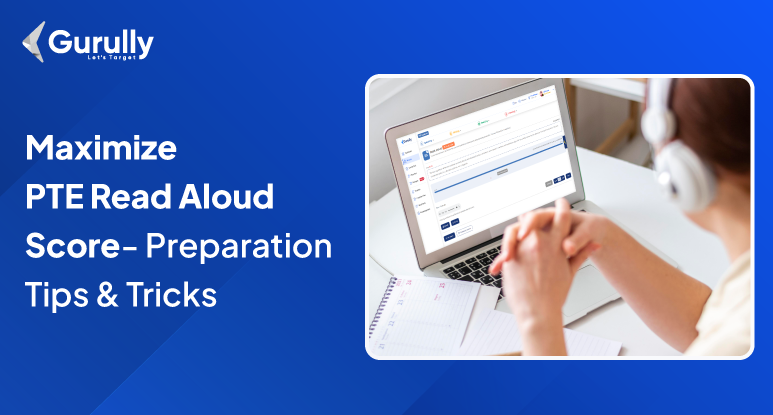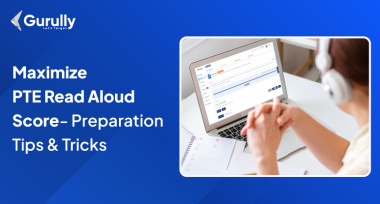Are you struggling with the PTE Read Aloud task? You’re not alone! The reading section may seem straightforward, but it’s a challenging combination of fluency, pronunciation, and content accuracy. To maximize your score, you must ace the PTE Read Aloud task. So here are effective PTE Read Aloud tips to help you deliver your best responses.
What Is the PTE Read Aloud Task?
In the Read Aloud task, you’re required to read a sentence or short passage from the screen within 40 seconds. The system evaluates your fluency, pronunciation, and how well you maintain the passage’s content.
👉PTE Read Aloud tasks evaluate two skills: Reading and Speaking. This question has a higher weightage in overall scoring. So it is very important that you prepare well for this question-type.
PTE Read Aloud Scoring Pattern:
PTE read aloud scoring is done based on these three factors: Content, Oral Fluency & Pronunciation
Content
| For Content you be scored on the following factors: |
|
Note: Maximum score depends on the length of the task prompt.
Myth: Following the one Line strategy for PTE Read Aloud will decrease your score in content. However, your fluency and pronunciation will be intact. So make sure you are following the right tips for it.
Oral Fluency
| For fluency factors, you will be given points on the following basis: | |
| Native Like | 5 |
| Advanced | 4 |
| Good | 3 |
| Intermediate | 2 |
| Limited | 1 |
| Disfluent | 0 |
Easy Breakdown Of Oral Fluency Factors:
- Native-like: Speech is smooth with no pauses, mistakes, or changes. Sounds like a native speaker.
- Advanced: Speech flows well with just one minor pause or mistake. Sounds nearly native.
- Good: Speech is clear but may have a few pauses or minor mistakes. Still the flow is well.
- Intermediate: Speech is a bit choppy, with some pauses or mistakes, but there’s at least one smooth part.
- Limited: Speech is uneven, with many pauses and mistakes, making it sound broken or off.
- Disfluent: Speech is very slow and difficult to understand as it has many pauses and mistakes.
Pronunciation:
| For pronunciation factors, you will be given points on the following basis: | |
| Native Like | 5 |
| Advanced | 4 |
| Good | 3 |
| Intermediate | 2 |
| Intrusive | 1 |
| Non-English | 0 |
Easy Breakdown Of Pronunciation Factors:
- Native-like: All sounds(vowels & consonants) are clear, and your speech is easily understood. You place stress on the right words, and it flows naturally.
- Advanced: Almost all sounds (vowels & consonants) are correct, with only a few minor mistakes. Everything is easy to understand, and stress is placed well on common words.
- Good: Most sounds are correct, but some words might be unclear due to minor mistakes. Stress might be off in a few words.
- Intermediate: Several sounds are mispronounced, but most of your words are understandable. Some words may be missing sounds, and stress is placed incorrectly sometimes.
- Intrusive: Many sounds are wrong, making your speech hard to understand. There’s a strong foreign accent, and stress is often misplaced.
- Non-English: Most of your pronunciation is incorrect, making it hard for listeners to understand more than half of your words.
Effective Preparation Tips & Strategies To Score High In Read Aloud
Practice Clear Pronunciation
While pronunciation is essential, make sure you’re covering the entire passage. Missing out words or skipping parts of the sentence can lead to a lower score in content. It’s okay if you’re not 100% accurate with pronunciation, but skipping words can hurt your score.
Strategy: Record yourself while reading aloud and listen for unclear sounds. Are there any words that you struggle to pronounce? Identify them and practice by breaking them down into syllables.
💡 Tip: Focus on speaking clearly and confidently. You don’t have to sound like a native speaker, but your words should be understandable
Improve Your Fluency
Before starting, take a quick glance at the passage of PTE read aloud question type. Identify any tricky words or names that may trip you up. This brief scan helps you feel more confident when it’s time to speak and will increase your fluency. Also, if you make a small mistake, don’t stop or go back to correct it. This breaks your fluency and can cost you points.
Strategy: Practice reading longer passages without pausing. If you find a word difficult, don’t stop—keep going! Your fluency score is affected more by pauses than by minor pronunciation issues.
💡 Tip: Don’t pause unnecessarily. The PTE AI system penalizes hesitation or unnatural gaps between words.
Maintain a Steady Pace
Nervousness can cause you to run out of breath mid-sentence. Practice breathing exercises that help you take deep breaths before starting and use pauses effectively to control your airflow during reading. This will help you maintain a steady pace.
Strategy: Maintain a moderate pace—not too fast or slow. Use a metronome app to time your speech so that you get used to maintaining a consistent speed. A smooth and steady rhythm makes your reading sound more natural.
💡 Tip: Don’t rush! Speaking too quickly can cause you to mispronounce words or stumble.
Focus on Intonation and Stress
Add natural rises and falls to your speech to sound more engaging and less monotone. Stress essential words to highlight the meaning of sentences.
Strategy: Practice stressing keywords and adding intonation at the right places. Try reading short sentences with different emotional tones (excitement, questioning, etc.). This helps you gain control over your speech pattern, making you sound more natural and engaging.
💡 Tip: Add a natural rise and fall to your speech to sound more engaging.
Be Mindful of Punctuation
Punctuation marks are cues for natural pauses in speech. Pausing briefly at commas and periods can improve your flow and clarity.
Strategy: When you see a comma or period, take a brief, controlled pause. However, avoid long pauses that break the flow. This helps structure your response and makes your reading sound smoother.
💡 Tip: Punctuation is your friend! It helps guide the natural pauses in your reading.
Build Vocabulary for PTE Read Aloud
Expanding your vocabulary will make it easier to read texts without stumbling over unfamiliar words.
Strategy: Read a variety of texts in your practice routine—news articles, blogs, academic journals. This will expose you to a range of vocabulary that might appear on test day.
💡 Tip: Strong vocabulary knowledge can help you confidently read aloud without stumbling over unfamiliar words.
Work on Clarity of Speech
The more anxious you are, the more likely you are to stumble. Keep calm, speak with confidence, and maintain a steady rhythm. Remember, the system isn’t grading your accent but how well you deliver the passage.
Strategy: Practice repeating words clearly. You can play tongue-twisters or simply record yourself reading aloud. Focus on articulating each sound without blending words.
💡 Tip: It’s not about speaking louder but speaking clearly.
Use PTE Mock Tests to Simulate the Test Environment
Regular practice in a test-like environment helps you get used to the format and reduces anxiety during the actual exam.
Strategy: Give PTE mock test with real-time exam simulation to practice in a timed setting. This will help you manage stress and perform better under pressure. Gurully’s Mock Tests are a great place to start, as they mimic the real test experience.
💡 Tip: Familiarity with the test format will help you stay calm and composed.
PTE Read Aloud Template
- Pre-Reading: Scan for Difficult Words
Before starting, quickly identify words that might be challenging to pronounce. Then, familiarize yourself with the passage’s structure at a glance.
- Starting the Read Aloud
- Start confidently: Take a deep breath and begin speaking clearly.
- Moderate speed: Maintain a natural pace, not too fast or slow.
- During Reading: Pronunciation & Fluency
- Pronunciation: Focus on clarity. Pronounce each word fully, especially the challenging ones.
- Fluency: Avoid unnecessary pauses and smooth the flow between words and sentences.
- Intonation: Use natural tone variations to emphasize important words and structure your speech.
- After Reading
Finish with a smooth tone, avoiding abrupt stops or drops in energy.
Pro Tip – You can also use our PTE Score Calculator for compering your PTE score with IELTS Score.
Sample Question and Answer For PTE Read Aloud Practice
Text:
A team of international researchers has uncovered a fascinating phenomenon: in response to rising global temperatures, Himalayan glaciers are actively working to preserve themselves by cooling the air in contact with their ice surface. However, it remains unclear how long these glaciers can continue to fight back against the effects of climate change.
Read or record your response on phone or any other device.
Now, check the correct response and evaluate where you are wrong.
Text :
An endlessly rotating beach ball, a program that crashes without saving data or systems that require illogical procedures or simply do not work. Unfortunately, struggling with computers is still a familiar situation for most of us. Tearing your hair out over computers that do not work remains very common among users, according to new Danish research.
Read or record your response on phone or any other device.
Now, check the correct response and evaluate where you are wrong.
For effective practice, you can opt for Gurully’s online practice platform. You will get question-wise practice where you can strengthen your read-aloud skills. Along with that, you can also give section-wise tests and know where your practice is lacking. Gurully’s online PTE practice platform provides full-length mock tests with AI scoring. Get expert-curated mock tests with real-time exam simulation to score high and achieve your dreams.
Conclusion:
PTE Read Aloud section requires a balance of fluency, pronunciation, and content accuracy. You can boost your score by practicing clear pronunciation, maintaining a steady pace, and improving fluency. Focus on speaking confidently, use natural intonation, and pay attention to punctuation for smooth reading. Regular practice, especially with mock tests, will help you stay calm and perform better on test day.
📚 Also Read:
- Find PTE Exam Dates & List of PTE Exam Centers In India
- Top 10 Free PTE Practice Websites To Help You Score 79+
- PTE Summarize Written Text Template With Predictive Questions & Answers to Score High
 Free PTE Practice Test
Free PTE Practice Test










